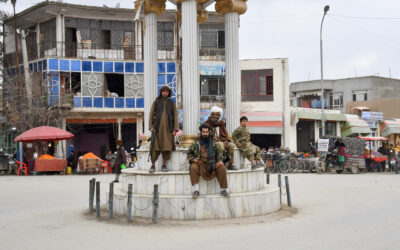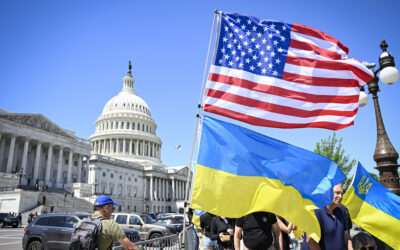
The Long Arm of China’s Security Services
SUBSCRIBER+ EXCLUSIVE REPORTING — When Chinese President Xi Jinping came to San Francisco last November to meet with President Joe Biden, Chinese pro-democracy activists in […] More
EXPERT PERSPECTIVE – The on-going bloody terrorist violence against Shia mosques in Afghan cities like Kunduz, Kandahar, and elsewhere have highlighted the murky issue of terrorism in Afghanistan since the Taliban takeover two months ago.
The continued presence of terrorism across Afghanistan has created a complex situation for future relations with the United States. Several factors have driven the tensions among the three main terrorist organizations: al-Qa’ida, the Haqqani Network, and the Islamic State-Khorasan Province or ISKP, and their relationship to the Taliban. Those factors include ideology, territory, worldview, and recent history. In addition, other smaller groups continue to operate in Afghanistan. They include the Tehrik-e-Taliban TTP), the Islamic Movement of Uzbekistan (IMU), and the Eastern Turkistan Islamic Movement (ETIM).
Washington’s future relations with Afghanistan will depend on collecting good intelligence about these groups and their ideological narratives, and whether they perceive their jihad as local operations against their perceived enemies or part of a global strategy to inflict mayhem and destruction outside of Afghanistan.
The United States and its allies remain a target of these groups for the foreseeable future. Their inability to conduct spectacular operations similar to 9/11, does not mean that they have adopted a reconciliatory attitude toward the West or that they have renounced violence. Even if some factions within the Taliban are adopting a more “pragmatic” approach toward the United States, a Taliban government – in which the leader of the Haqqani Network Sirajuddin Haqqani serves as Minister of the Interior – would not be hostile to their long-term allies within al-Qa’ida and other terrorist groups.
Lasting Bonds
In order to understand the interactions among the different terrorist groups, it’s useful to remember that the Taliban, al-Qa’ida, and the Haqqani Group have been closely aligned ideologically and operationally for nearly three decades. Their jihad against the Russian forces in Afghanistan, and later against the Americans, cemented alliances among them. Some of their leaders grew up together, and some have died, or “martyred,” together.
Kindship bonds and intermarriages helped them survive their differences. However, they shared no command and control and conducted their violent acts separately. It would be a mistake to view them as discrete, static organizations that can be separated easily.
The bond of jihad is constantly re-enforced by their social, tribal, and family connections that were forged among Afghan and Arab mujahideen and jihadists in the past two to three decades. Many young Arab jihadists who flocked to Afghanistan in the 1980s, to fight the Soviet forces, stayed on after the forced Soviet withdrawal from that country, married Afghan women, and raised their families in Afghanistan. Thousands of them, however, either fled the country following the American invasion in the fall of 2001, were killed in the fighting, or were arrested by Pakistani or American troops.
The Cipher Brief hosts private briefings with the world’s most experienced national and global security experts. Become a member today.
Ideology of Jihad
Al-Qa’ida Central and its affiliates, including al-Qa’ida in South Asia (AQIS), and ISIS Central and its affiliates, including ISKP, the Islamic Movement of Uzbekistan (IMU), and the Eastern Turkmenistan Islamic Movement (ETIM), share the same Saudi-based Ibn Taymiyya, Hanbali, Salafi Wahhabi radical, intolerant interpretation of Islam. Their ultimate goal is to recreate an Islamic State that resembles the Islamic State that the Prophet Muhammad established in Medina in the 620s CE, although they differ on the timing and the means on how to get there. They view the world as divided between Dar al-Islam or the House of peace and Dar al-Harb or the House of war. Peaceful coexistence between the two is possible only when states residing in Dar al-Harb conclude amity covenants with Dar al-Islam.
This intolerant narrative views most non-Muslim residents in Dar al-Harb as infidels, unbelievers, apostates, and potential enemies of Islam. Usama Bin Ladin (UBL) articulated this message effectively and used it to justify the 9/11 and other attacks on the United States as a symbol of “Crusader infidels.” The textbooks that UBL studied in Saudi schools preached the same worldview against those who disagreed with the Salafi Wahhabi doctrine, including Shia Muslims and Jews. He viewed the United States, as the new “Crusades” and accused it of waging a war against Islam and Muslim states.
The Islamic State under Abu Bakr al-Baghdadi preached a similar doctrine. Whereas UBL did not opt to attack Shia Muslims during his global jihad against the West, the Islamic State, under Baghdadi, conducted a series of bloody attacks against Shia Muslims and their places of worship. Currently in Afghanistan, ISKP is waging a similar brutal and bloody campaign against Shia mosques in which hundreds of innocent worshippers are being killed.
Go beyond the headlines with expert perspectives on today’s news with The Cipher Brief’s Daily Open-Source Podcast. Listen here or wherever you listen to podcasts.
The Haqqani Group and the Taliban adhere to a similarly intolerant and misogynistic ideology in Afghanistan, which they base on a rigid interpretation of the Deobandi-Hanafi narrative of Islam. Deobandi Islam in South Asia, especially in India—home of Darul Ulum, the largest Deobandi University in the world—has traditionally preached a relatively moderate version of Islam that was tolerant of non-Muslims. With the advent of the Taliban on the Afghan-Pakistan border and the Salaf-Wahhabi ideology from Saudi Arabia, a rigid and intolerant interpretation of Deobandi Islam began to emerge. This rigidity underpins their violent jihad, conservative attitudes toward and control of women, restriction on cultural activities and the arts, and banning of free press, speech, and political activity.
UBL and al-Qa’ida were the bridge linking Saudi Wahhabi Islam and South Asian rigid Deobandi Islam. Arabic, the language used in reciting the Qur’an, has been another unifying factor among the different terrorist groups. No wonder that Saudi Arabia was the first state to recognize the Afghan Islamic Emirate under Mulla Omar in the 1990s. Mulla Omar offered a fertile environment for al-Qa’ida’s terrorism to grow and prosper. The current Afghan Islamic Emirate—flush with American weapons and ruled by Taliban leaders who have been designated terrorists—does not promise to be any different. Furthermore, the three terrorist organizations plus the Taliban are committed to the rule of Sharia, (God’s rule or hukm), not to man-made government that is based on elections and constitutions.
The Good News
The good news is that al-Qa’ida Central and Isis Central are no longer as formidable as they used to be. Their recruitment, resources, and ability to plot and plan spectacular global operations have been curtailed significantly. The Haqqani Network, as part of the new Taliban regime, most likely will follow the Taliban’s emerging “pragmatic” approach to relations with other countries in order to secure economic aid, trade relations, and recognition.
ISKP, AQIS, IMU, ETIM, and TTP are small groups and are focused on retaining limited geographic areas within Afghanistan in which they operate. Their terrorism targets other groups within Afghanistan, China (in the case of ETIM), the Pakistani security (in the case of TTP), and the Taliban and foreign presence (in the case of ISKP). None of them has the capability to conduct operations beyond Afghanistan, unless of course they have sleeper cells in other countries.
The Bad News
Al-Qa’ida and ISIS affiliated groups could still cause havoc against American and allied targets in the United States and elsewhere through self-radicalized individuals or sleeper cells. In order to mitigate the new phase of terrorism, it’s crucial for the United Sates to sharpen its intelligence collection capabilities across Afghanistan and neighboring states in South and Central Asia. In many places over the years, the United States was able to collect intelligence and information without having boots on the ground. Afghanistan is no different.
Read more expert-driven national security news, insights and perspective in The Cipher Brief
Related Articles

SUBSCRIBER+ EXCLUSIVE REPORTING — When Chinese President Xi Jinping came to San Francisco last November to meet with President Joe Biden, Chinese pro-democracy activists in […] More

SUBSCRIBER+EXCLUSIVE EXPERT PERSPECTIVE — More than two years after its withdrawal from Afghanistan, the U.S. still does not have a clear way forward in the […] More

SUBSCRIBER+ EXCLUSIVE REPORTING — Ukrainians greeted Saturday’s long-awaited House passage of $60.8 billion in aid with justifiable jubilation. For months, their soldiers, civilians, and political […] More

SUBSCRIBER+ EXCLUSIVE REPORTING — A race for control of space is underway, and just as on earth, the U.S. and China are the top competitors. […] More

SUBSCRIBER+ EXCLUSIVE REPORTING — For nearly a week, the Middle East and much of the world were on a knife’s edge, waiting for a promised […] More

BOTTOM LINE UP FRONT – Less than one week after Iran’s attack against Israel, Israel struck Iran early on Friday, hitting a military air base […] More
Search